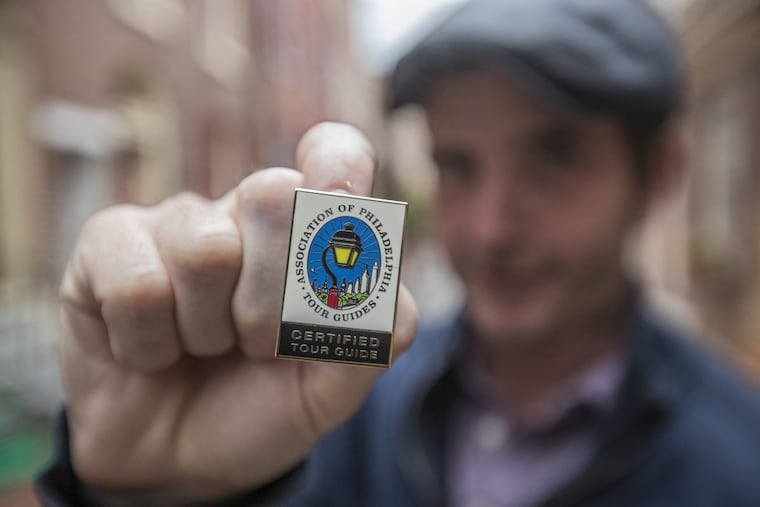A tour of Philly's first outlaw district - an 18th-century Sips - by yours truly
My career as a Philadelphia tour guide will begin in earnest Saturday. Sort of.

After hours of backbreaking work; after grueling cram sessions bent over 250 pages of laser-printed facts on Philadelphia; after months of annoying loved ones, colleagues, and strangers with random, garbled factoids of Old Philly; after long nights spent polishing my guide pin by candlelight, my ship finally came in.
A tour. For me. At last.
My career as a Philadelphia tour guide will begin in earnest Saturday.
Sort of.
I have been offered a three- to five-minute guest guiding slot on the "Great 12-Hour, River to River, Vine to Pine, Walking Tour of Philadelphia." I'm not making that up. That's the name. Consider it the Tour de France of Philly Tour Guiding, a celebration of civic pride and superhuman endurance.
My first mission is a plum assignment: Helltown.
Philly's first red light district, once located along the waterfront, just north of Market Street. Where the spirits flowed, debauchery abounded, and the fights were furious. So, basically, 18th-century Sips.
I love Philly. I love knowing about Philly, and I love bothering people with what I know about Philly. So, it stands to reason that I love everything about the Great Tour.
In its seventh year, the tour is the handiwork of the Association of Philadelphia Tour Guides (APT). The group formed a decade ago, in the wake of some bad press, when some loose-with-the-facts guides were giving Philly guides a bad name by spouting blatantly wrong things about our city's history. Like Washington and Lincoln being close dining buddies. The APT folks wanted everyone on the same page – the right one. They drew up the handbook and a challenging certification course. It's the real deal. I took it myself.
(The National Park Service rangers who provide tours of Independence Hall and other historic city buildings have their own training.)
Philly guides are now earning national cred.
Gene Reyes, a tour guide in New Orleans and president of the National Federation of Tour Guides, said that with its new standards, encyclopedic guidebook (the endless tidbits in it will make you a hit at parties, or at least the ones I go to), and even a master guide program, Philly guides are becoming guides, well, to follow.
The national group even chose Philly for its annual conference coming up in February.
"We're very excited about going to Philadelphia," Reyes said. The guidance and leadership of the members there have made it so much easier for tour guides across the country. They set an example for others."
The guides still face challenges, though, the kind that accompany progress — their own and the city's. For one, as the city racks up more international cachet, there's an increased need for bilingual guides, they say. And there's the fancy renovations at the Bourse, long the destination food court for guides shepherding hordes of hungry school kids. (Fifth graders don't particularly like oysters and craft beer, goes the fear.) Also, with new towers going up on every corner, it's just getting harder to be heard. You can fry your vocal chords over the jackhammer's roar, guides will tell you.
Designed as both a way to show off the strides of the guides – and the city itself – the Great Tour has only grown, this year expecting about 300 people, said Edward Mauger, a founder member of APT and the tour organizer. This year's trek kicks off at the National Constitution Center at 8 a.m. Saturday and ends a dozen hours later at the Art Museum. A full schedule can be found at http://phillyguides.org/. The faint of foot can elect to join in anywhere along the way and pay the $20 fee. For the last phase only — the Parkway — it's just $10. (I'm not getting paid.)
In the meantime, I have been studying up on Helltown. Like any good guide, I sought help from someone who knows.
"That whole area was notorious for pirates, for smugglers, for debauchery, for prostitution – for everything," Daniel Rolph of the Historical Society of Pennsylvania told me Tuesday. "That was really Philly's first outlaw district."
Indeed. While Jefferson and Franklin and the others were enjoying their punch in the cozy confines of City Tavern, the denizens of Helltown were going crazy in the unlicensed tippling houses with names like Red Cow, Jolly Tar, and Rising Sun. Sailors stumbling from port. Servants sneaking out for a night on the town. Poor people who came to the colonies from all over chasing a better life, but who wound up in Helltown.
At the foot of Race Street, the most infamous colonial watering-hole, a hell-hole known the ocean over, was the Three Jolly Irishman. It was run by a thief and pimp named Cock Robbins and his "two adopted wives," Elizabeth McSwain and Mary Carrol. Together, they plied their trade: gambling, prostitution, and drugs, like Spanish Fly and Jesuit's Bark. An old German man, hunched and pinched from age, worked the door but never bothered to quell the nightly riots.
Bless his soul, but what could he do? the old man would reportedly shrug as the revelers tore the Irishman apart.
Come out Saturday and hear the rest of the story.
I'll be the guy wearing the shiny pin.